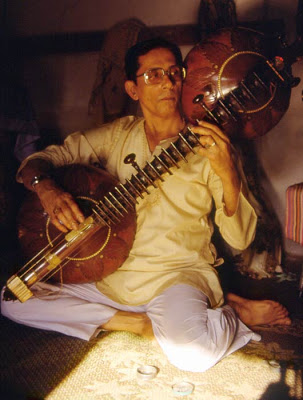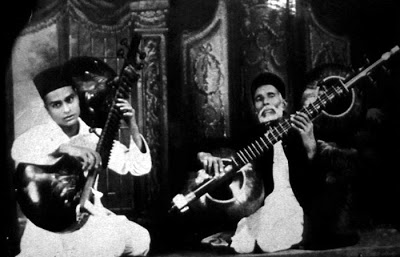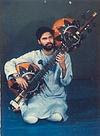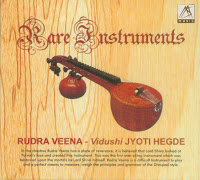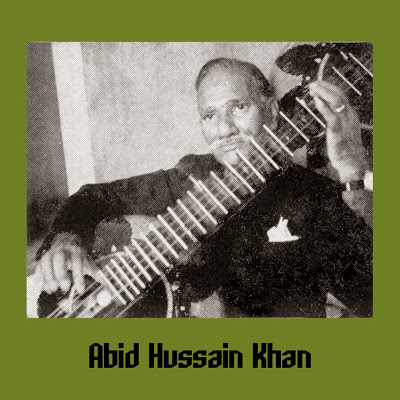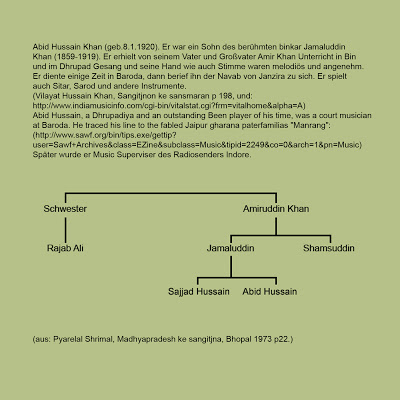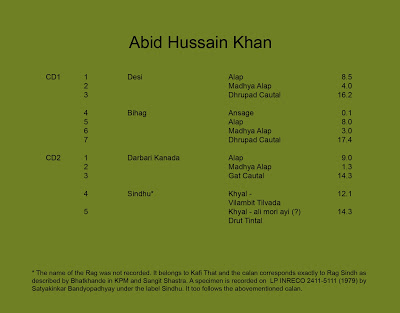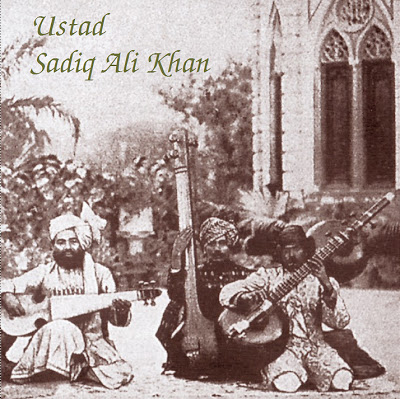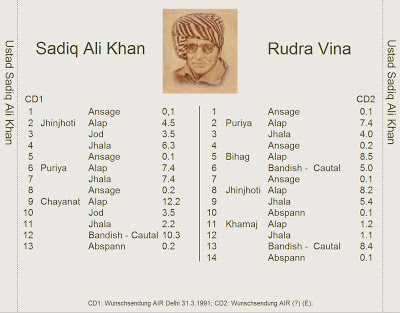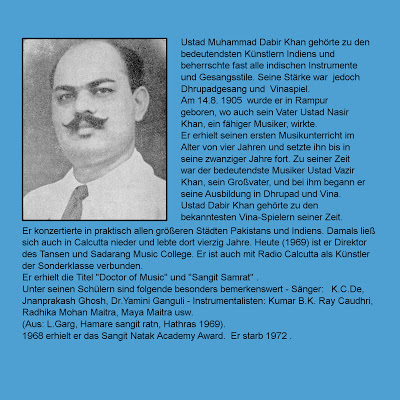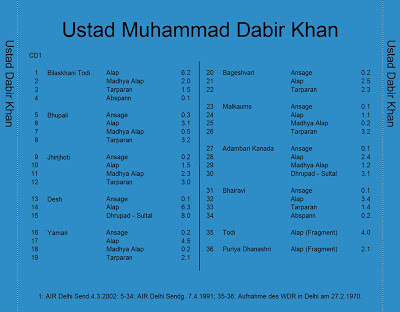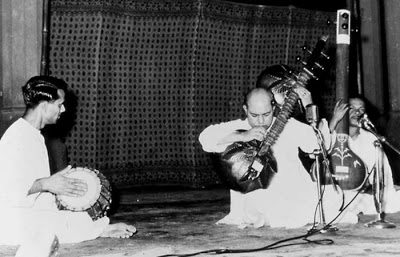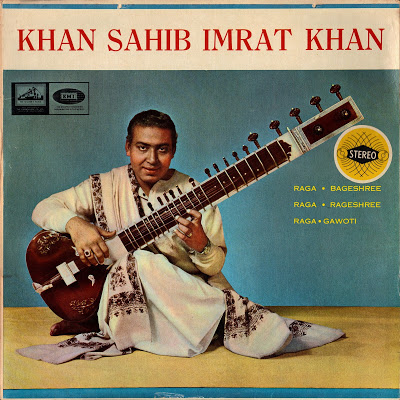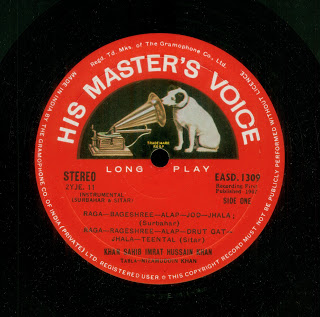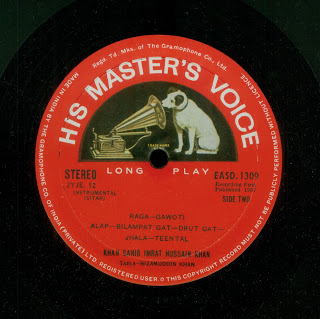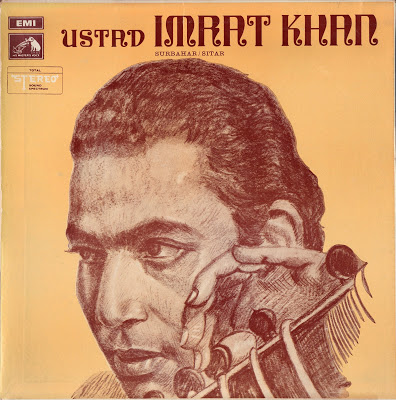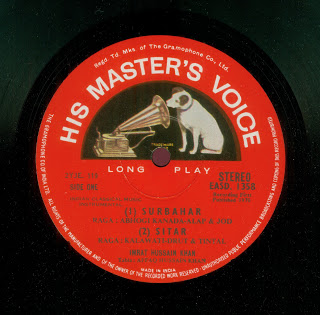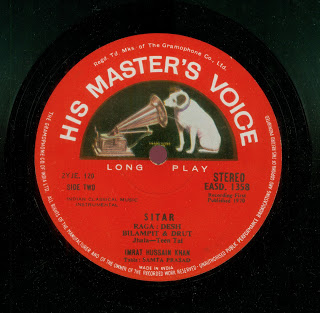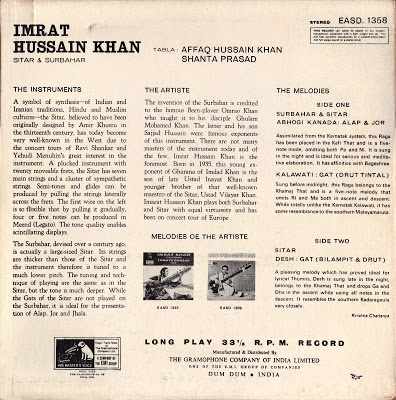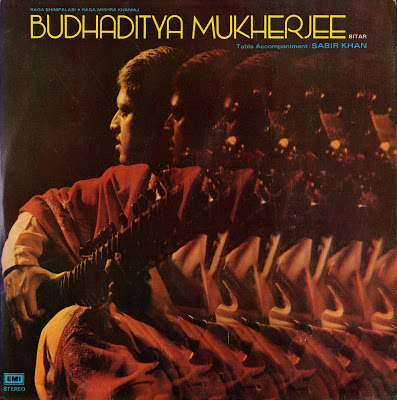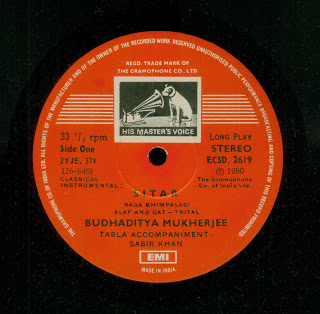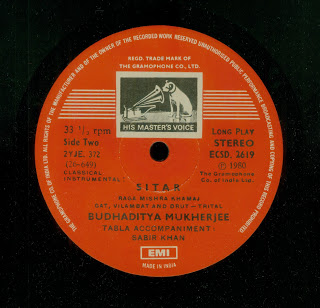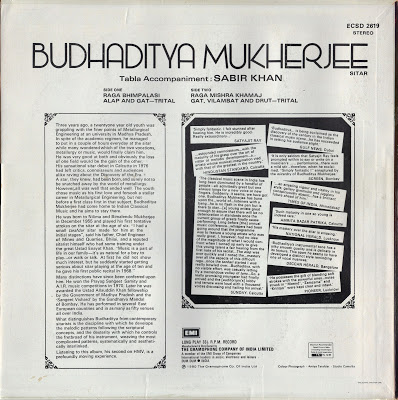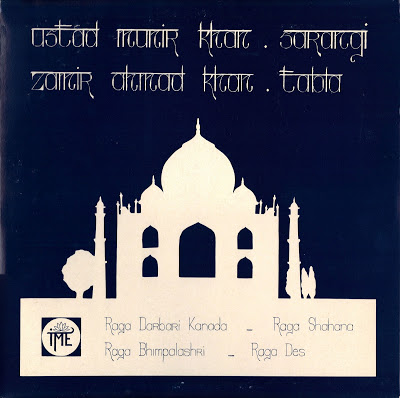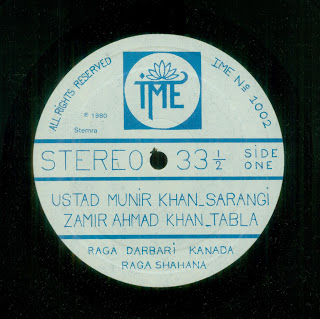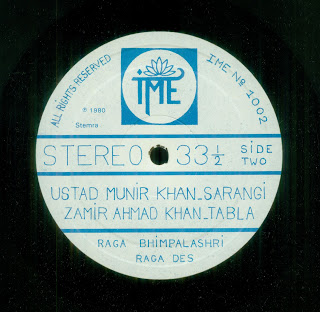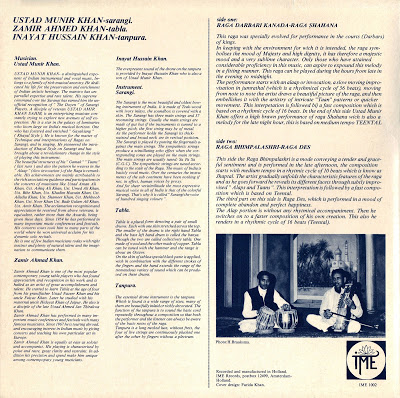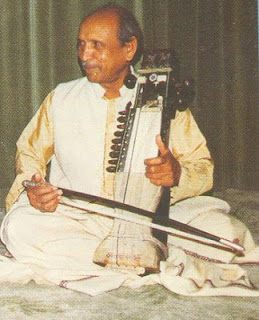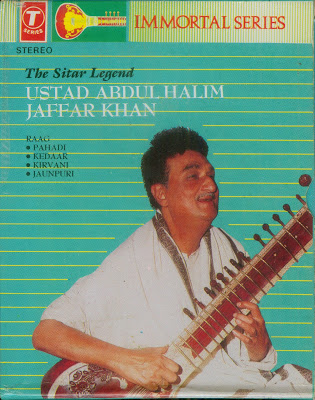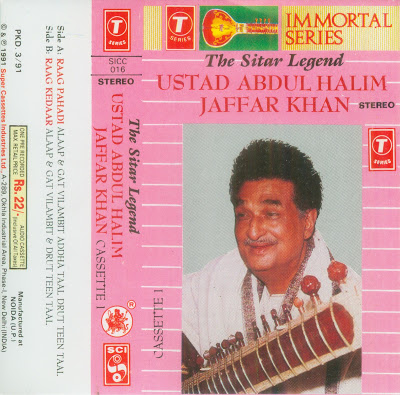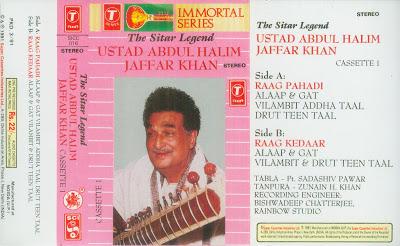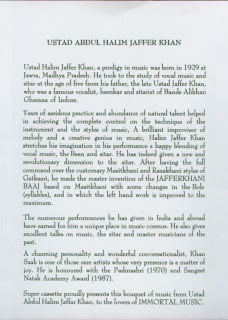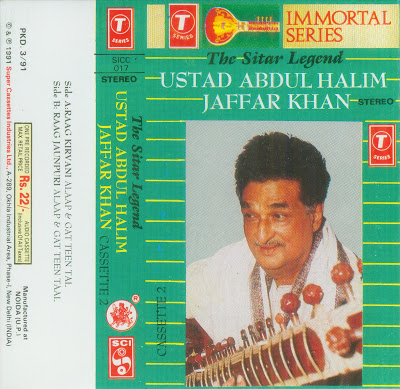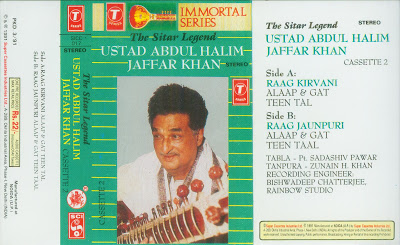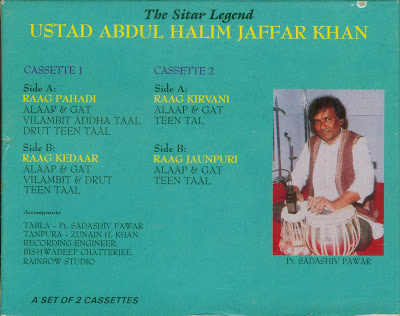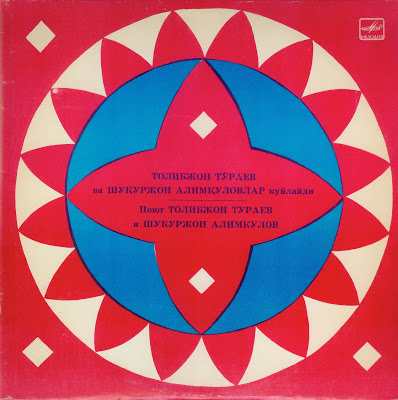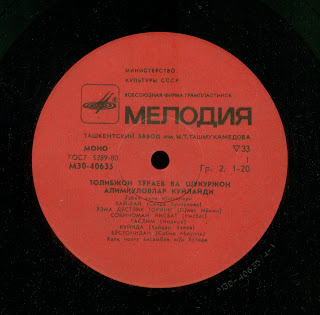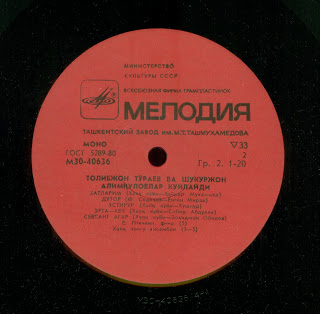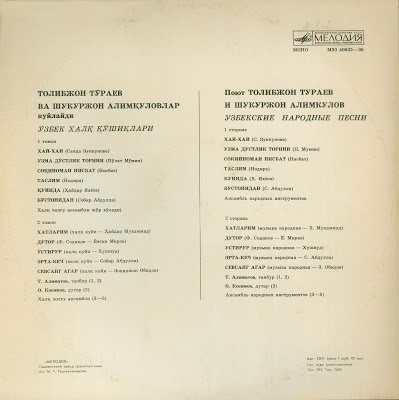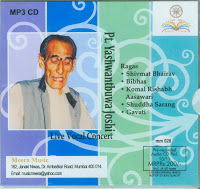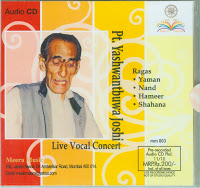Bindu Madhav Pathak
Here we present two Rudra Veena masters from Dharwar
in South India: Shrikant Pathak and R.V. Hegde. Both are students of Pandit
Bindu Madhav Pathak (1935-2004), an exponent of Rudraveena and Sitar.
Dr
Bindu Madhav Pathak was the son of a great Rudra Veena player Pt. Dattopant
Pathak and hails from Hubli. He obtained his early training from his
father (pupil of Late Ustad Murad Khan Beenkar of Jawara) and later from Ustad
Rajab Ali Khan of Dewas. Both Ustad Murad and Rajab Ali Khan were students of
the great Rudra Veena player Ustad Bande Ali Khan.
BMP blossomed into an
accomplished artist at a very young age of 17. He was a top 'A' grade artist of AIR. He performed in
several National Music Programmes of AIR and Doordarshan. Some of his students
are his son Shrikant Pathak, Ramchandra V Hegde and Jyoti Hegde. He was Head of
Dept. of Music in Karnataka University, Dharwad.
Pt Pathak was heavily influenced by the vocal music of Kirana Gharana (that of Abdul Wahid Khan). He insisted his gharana to be Kirana, and not formally associated with any Dhrupad gharanas. He said he played Khayal style (Kirana type) of music on Been.
Pt Pathak was heavily influenced by the vocal music of Kirana Gharana (that of Abdul Wahid Khan). He insisted his gharana to be Kirana, and not formally associated with any Dhrupad gharanas. He said he played Khayal style (Kirana type) of music on Been.
Mr. Pathak, who retired as the Head of the Department of Music of
Karnatak University, was popularly known as "Been" Pathak for his expertise in
playing the Been. Apart from performing for Akashwani and Doordarshan, he was a
recipient of several awards and titles including the Karnataka Kala Tilak Award,
Aryabhata Award, and "Vidyaparipoorna" title. He also served as adviser to the
Union Ministry of Education and Culture .
Mr. Pathak wrote many books and
articles on music, including Bharatiya Sangeeta Charitre.
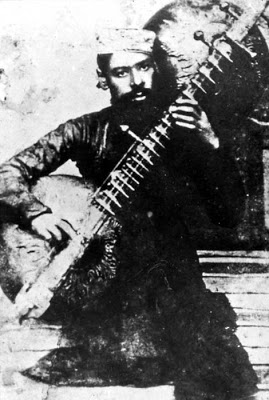
Bande Ali Khan
He belonged to the Khyal Ang Rudra Veena tradition. Khyal
Ang on veena began mainly with Bande Ali Khan (credited: 1826-1890). An
innovative and iconoclastic musician, Bande Ali Khan was particularly fond of
khyal singing, which he adapted to the bin, the instrument having until then
been solely used to interpret the dhrupad style.
Murad Khan (on the right) and his disciple Krishnarao Kholapure
His
student Murad Khan was the one who propagated this unorthodox innovation through
the state of Maharashtra. Hindraj Divekar, Bindumadhav Pathak, Jyothi Hegde, and
a number of other beenkars belong to this tradition and play khyal and dhrupad
ang.
Another point to note is these people including Bindu Madhavji
played a been manufactured in Miraj (Maharashtra), whereas others like Bahauddin
Dagar play ones from Kolkatta (from what I know).
Information collected
from a Dhrupad enthousiast from Hubli, Dharwar, from the book "Rudra Veena: An Ancient String
Musical Instrument" by Pandit Hindraj Divekar (see here) and from the excellent
website: http://www.rudravina.com/
See also here.
See also here.
The fotos above are from the website
www.rudravina.com.
As we were not able to find any recordings by Bindu Madhav Pathak, we present here two musicians belonging to his tradition: his son Shrikant Pathak and his student R.V. Hegde. The music is from All India Radio. We found the recordings a while ago in the internet. Unfortunately we don't remember
the names of the original uploaders.
Shrikant Pathak (Rudra Veena) - Raga Madhumad Sarang (27:55)
R.V. Hegde (Rudra Veena) - Raga Ahir Bhairav (24:00)
Shrikant Pathak took Been playing professionally. He has an MA in music and
holds a Ph.D. He teaches Sitar at Pandit Panchakshari Gawai music college run by
Veereshwar Punyashram, Gadag.
Ramachandra V. Hegde was born in 1953 at Halladkai in Sirsi Taluk, Karnataka in
a family with a rich musical background. His grandfather was a well known
musician in that area and as a child he grew up in a house steeped in music. He
began learning Hindustani Vocal and is an accomplished singer but was fascinated
by the Sitar. His love for the Sitar made him give up singing and soon he began
his training under Pt. (Dr.) Bindu Madhav Pathak, a well known Sitar and
Rudraveena player of the Bande Ali Khan Gharana. Under Pt (Dr.) Bindu Madhav
Pathak’s guidance he soon learnt the intricacies of the Sitar. He was also lucky
enough to get a guru who was an accomplished player of the Rudraveena.
The Rudraveena is not an easy instrument to master and there are only a handful of artists who play the Rudraveena. Under Pt (Dr.) Bindu Madhav Pathak’s guidance, Ramachandra Hegde was able to master both these classical Indian Stringed Instruments.
Apart from playing the Sitar and the Rudraveena, Ramachandra Hegde believes in keeping the music of the Rudraveena alive for generations to come. He teaches music and trains young pupils from all over the country. Many of his students have gone on to become All India Radio Artists themselves.
from: http://www.angelfire.com/planet/rudraveena/Rudraveena/index.blog/1266513/rudraveena/
If anybody has more information or more recordings by these artists or other artists from this tradition, please share.
Addition of 19th of january 2018:
Just found on YouTube an extremely difficult to get CD by R.V. Hegde, posted by the label in CD quality: https://www.youtube.com/watch?v=1WmGlRWSUrM&t=9s
The Rudraveena is not an easy instrument to master and there are only a handful of artists who play the Rudraveena. Under Pt (Dr.) Bindu Madhav Pathak’s guidance, Ramachandra Hegde was able to master both these classical Indian Stringed Instruments.
Apart from playing the Sitar and the Rudraveena, Ramachandra Hegde believes in keeping the music of the Rudraveena alive for generations to come. He teaches music and trains young pupils from all over the country. Many of his students have gone on to become All India Radio Artists themselves.
from: http://www.angelfire.com/planet/rudraveena/Rudraveena/index.blog/1266513/rudraveena/
If anybody has more information or more recordings by these artists or other artists from this tradition, please share.
Addition of 19th of january 2018:
Just found on YouTube an extremely difficult to get CD by R.V. Hegde, posted by the label in CD quality: https://www.youtube.com/watch?v=1WmGlRWSUrM&t=9s
Recently in India a CD by Jyoti Hegde was published:
Jyoti Hegde (Rudra Veena) & ? (Pakhawaj) – Rare Instruments - Rudra Veena:
Raga Miyan Malhar: Alap, Jod & Jhala, Dhrupad Bandish in Chautala, Raga Megh
Malhar: Alap & Jhala, Dhrupad Bandish in Jhaptal, ASA MUSIC,
ASA-MGD-G039
Unfortunately the label put a picture of the Saraswati Veena instead of the Rudra Veena on the cover.
